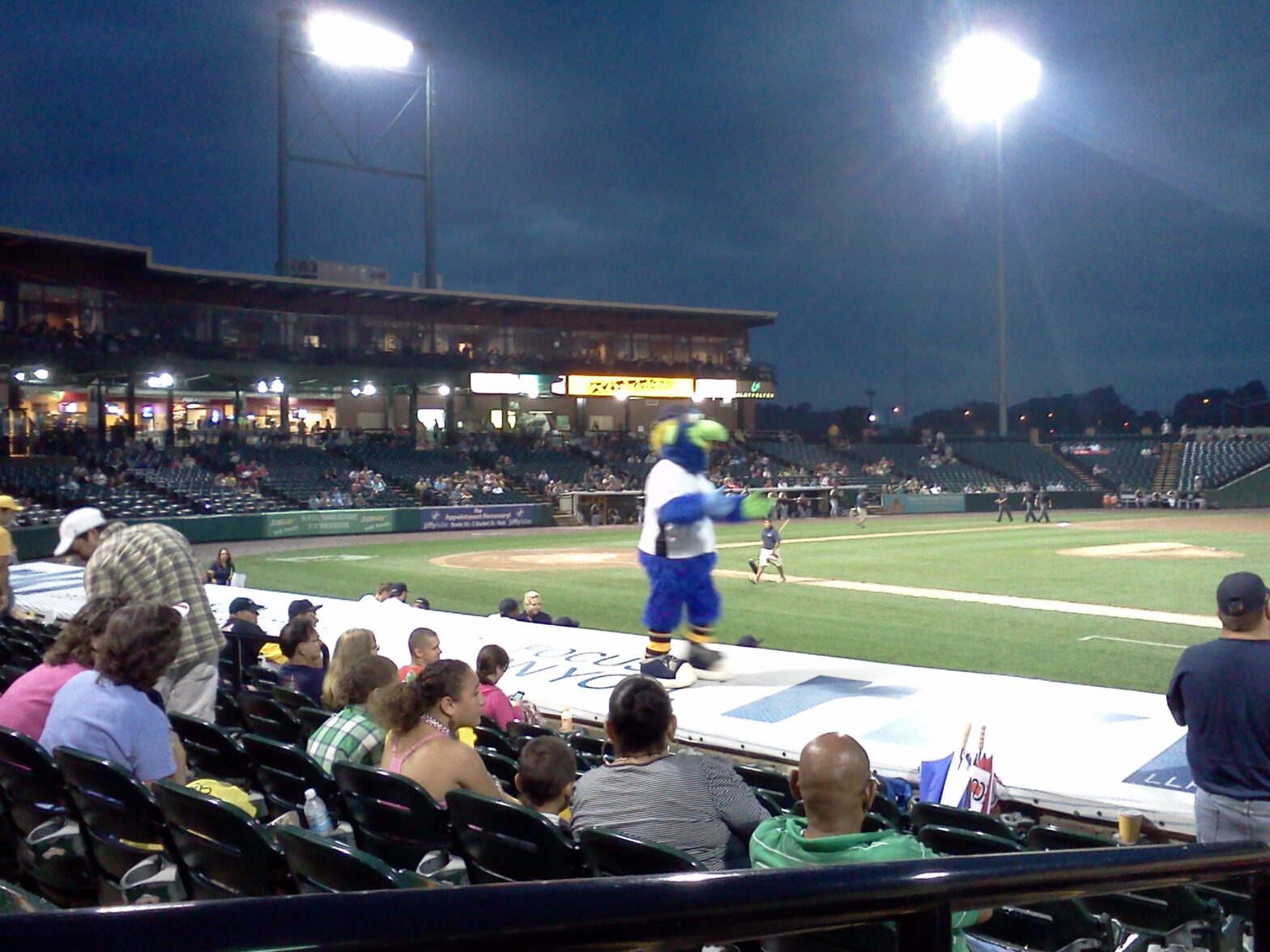Saturday night I attended my first York Revolution game in about a month. The Revs were playing the Sugar Land Skeeters.
The York Revolution are my local profession baseball team. The Harrisburg Senators, Washington’s AA affiliate, are my closest affiliated team, but they’re a good forty minute drive from my apartment. Sovereign Bank Stadium, the home park of the Revolution, located in downtown York in the Market District, on the other hand, is about eight miles and fifteen minutes (depending on traffic, to be fair) from my place.
The Revs are in the independent Atlantic League, and I’ve attended a half-dozen Revs games since the season began. One of the unaffiliated minor leagues, the Atlantic League is an eight-team league (mostly) based in the mid-Atlantic, with an expansion team near Leesburg, Virginia beginning play next year. (How will expansion be handled? Unless the Atlantic League gets a team to jump from another independent league, the league will probably assemble and manage a traveling team, probably called the Road Warriors, who will play all 140 games on the road.) NPR reporter Neal Conan called the Atlantic League “the last chance league” in his book Play By Play; the league’s rosters are filled with former major leaguers looking for another shot at glory, former prospects who washed out of the affiliated minors hoping to prove to a scout that deserve another shot, and players who have no expectations but really just love the game. I know of two links between the Nationals and the Atlantic League, though they may easily be more; Nationals bullpen catcher Octavio Martinez played for York and finished his professional playing career last year with Sugar Land, and Harrisburg’s Jimmy Van Ostrand was signed by the Nationals last year out of Sugar Land.
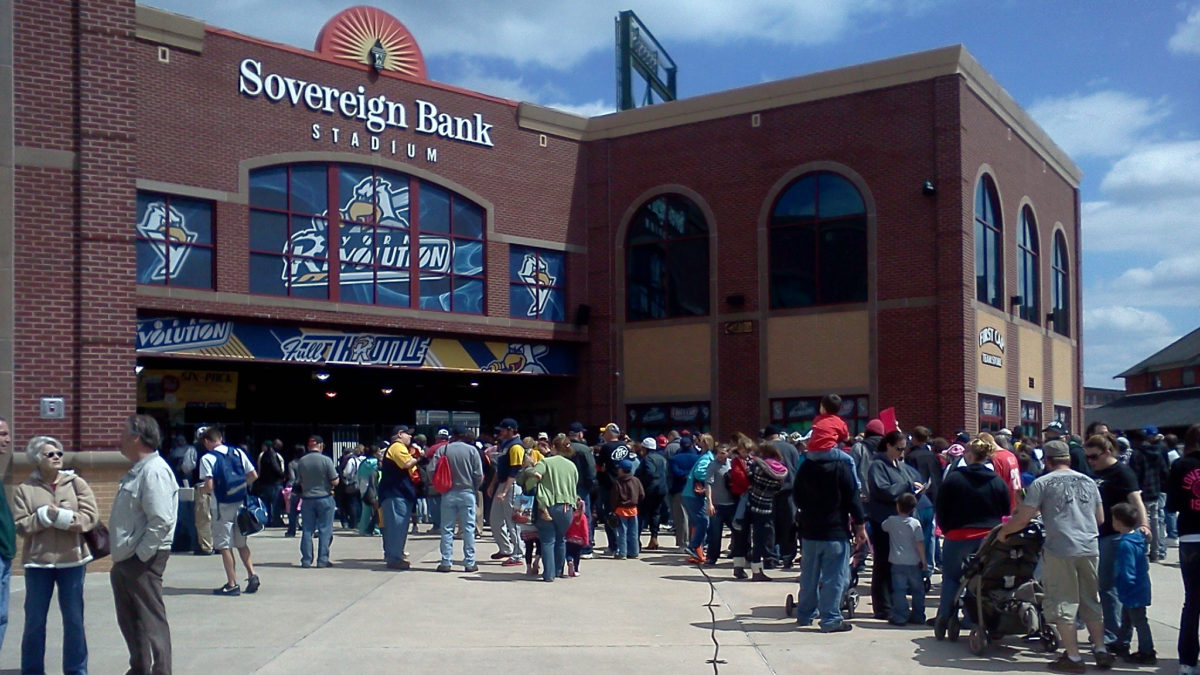
(Note: This picture of the stadium was taken in April on Fan Fest Day.)
Sovereign Bank Stadium, to be renamed Santander Stadium in 2014, opened in the summer of 2007, the Revolution’s first year in the Atlantic League. As I understand it, one of York’s former mayors wanted to bring minor league baseball back to York after a decades-long absence; York had been the home of the White Roses, the minor league team where Orioles great Brooks Robinson got his start. However, the ownership of the Harrisburg Senators refused permission for an affiliated team in York — it would have been a territorial encroachment, as downtown York is within thirty-five miles of Harrisburg’s stadium — so York went the route of nearby Lancaster, also within Harrisburg’s territory, and worked with the Atlantic League to bring an unaffiliated team, and thus unbound by Minor League Baseball territorial rules, to the city. The Revolution’s first few seasons were not promising, but then under manager Andy Etchebarren the Revolution won the Atlantic League pennant in 2010 and 2011 and reaches the playoffs again in 2012.
Sovereign Bank Stadium is generally a good place to watch a game. The stadium, like other Peter Kirk designs, is designed for family outings; there’s a carousel beyond the outfield wall and a children’s playground with slides and the like. The seating bowl is configured so that all seats, including the seats at the ends along the foul lines in the outfield, face the infield. The seating rise along the foul lines can make it difficult, if not impossible, to see plays in the outfield corner nearest your seat, and seats at the end of the seating bowl have to turn around to see plays in the outfield closest to them. The one thing Sovereign Bank doesn’t have that I miss from other ballparks is concession vendors walking the aisles. There’s also a standing room only field seats on the grassy hill beyond the outfield; there were, surprisingly, a few people out there as late as midnight.
Concessions range from the typical ballpark fare (hot dogs) and a pretzel stand (I recommend the pretzel dogs) to higher-end specialty sandwiches and microbrews; prices are a little more than comparable items at Harrisburg’s Metro Bank Park (except, curiously, for the ice cream, which is actually cheaper than at Metro Bank) and they’re less than Nationals Park. And, of course, they have an official team store.
Rain was in the forecast for Saturday afternoon and the skies grew cloudy, but it wasn’t until I was on my way to the game that the first sign of a storm manifested. As I was driving up George Street into York’s downtown I saw lightning in the distance, and as I parked in the Small Athletic Field across Codorus Creek from the stadium I heard the thunder.
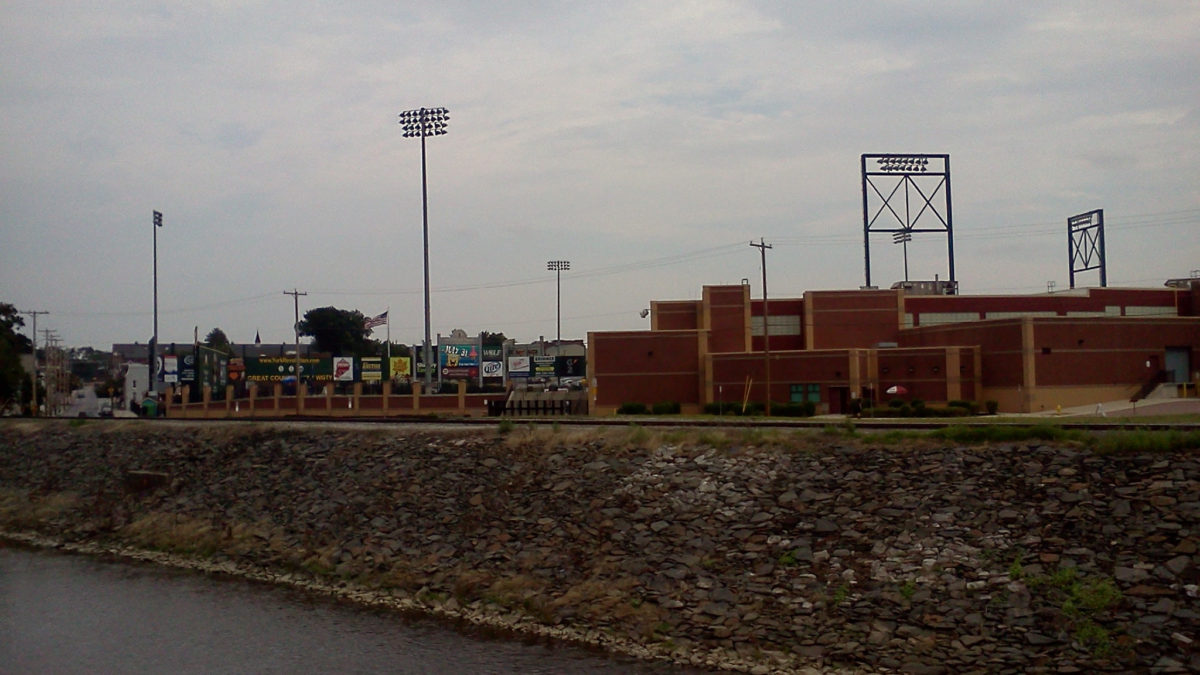
In spite of the threatened weather there was a good crowd outside the stadium gates when I arrived there about ten minutes before the gates opened. I had no particular reason for getting to the stadium that early; the evening’s giveaway — a flyswatter, to swat the Skeeters — was cute in a conceptual way, but nothing worth getting excited over. No, I simply like to be early when I can be, especially because on the days that I’ve gone to games after work, I typically don’t arrive until midway through the first inning. I made the right choice getting to the field early; the rain started to fall shortly after they opened the gates.
The tarp was already on the field, and I went ahead and found my seat. The rain was light, and I read through the program, Revolutionay Times. There were two articles of note to Nationals fans. One was on famous people who have visited Sovereign Bank Stadium, and it pictured the racing Presidents who have visited the park twice. The other was a partial transcript of the interview with Octavio Martinez, the Nationals bullpen catcher, that I linked to above. Then the rain really began to fall, and everyone who had taken their seats in the seating bowl, all of which is exposed to the elements, fled for cover under the overhang.
Then it became a matter of waiting for the rain to stop.
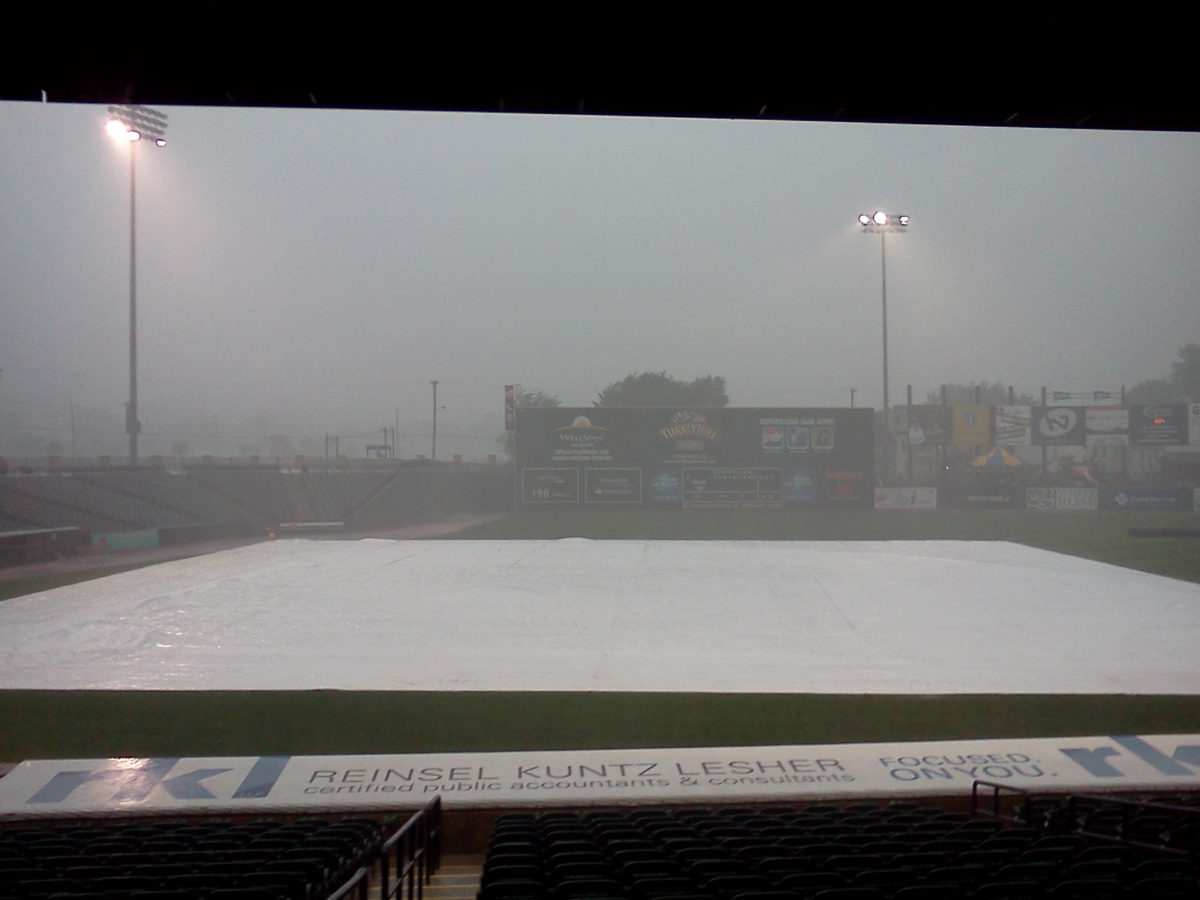
Close to 6:30, the scheduled time for first pitch, and with the rain apparently never about to let up, they made an announcement over the PA system that the night’s post-game fireworks were being canceled due to York City’s sound curfew. They still intended to play the game once the storm passed, and attendees would receive a voucher as they left the stadium for a free admission to one of the remaining games of the season.
The rain would slacken, then resume as hard as ever. The grounds crew came out once and began to peel back the tarp, and then the rain intensified and drove them under cover in the visitors bullpen. The Skeeters sent their starting pitcher Scott Elarton out into left field to warm up in the light drizzle, and he too was driven back out of the storm.
Finally, close to quarter past eight, the rain trickled off to nothing. The grounds crew came out and took up the tarp. I had never seen a tarp removed from the field before, and I had no idea how it was done. I was really quite impressed. The two teams came out and began doing their warm-up exercises on the field. Meanwhile, the ushers were attempting to dry off as many seats as they could. I took matters into my own hands and came out of the restroom with enough paper towels to take care of mine.
Two hours past the scheduled first pitch time, Downtown, the team’s mascot came out to pump up the crowd.
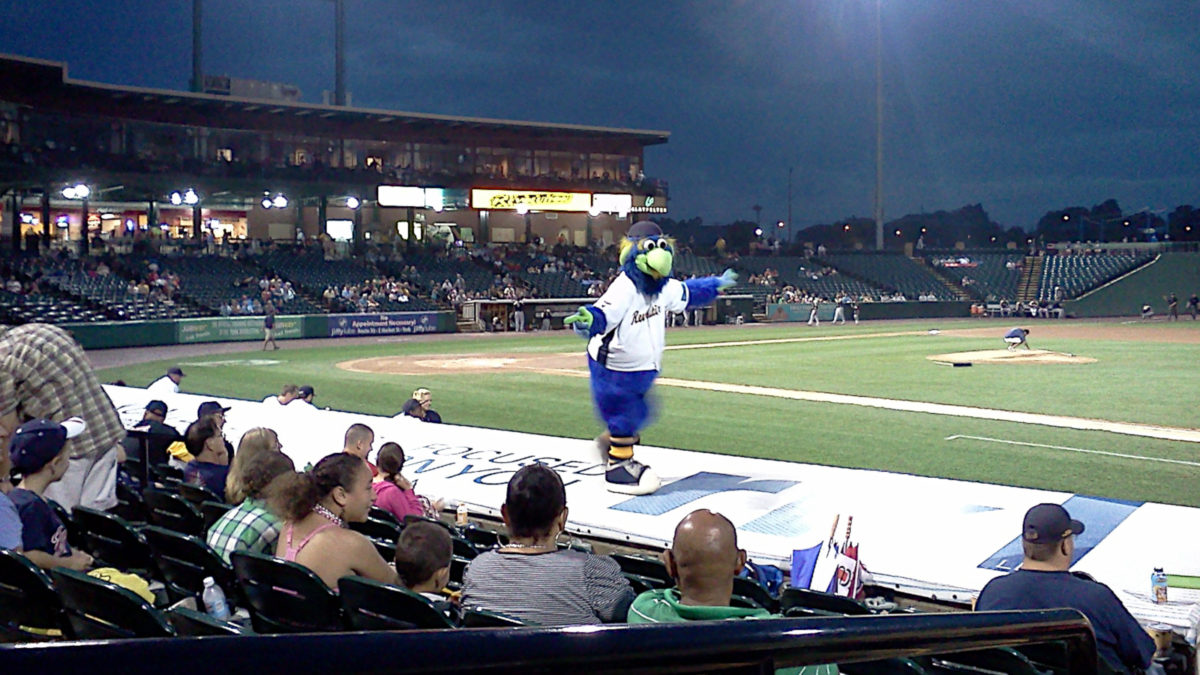
There wasn’t much of a crowd. The forecasted rain probably kept many away, and the lack of a firm starting time or the cancelation of the fireworks sent some families home.
DownTown was the reason why I hadn’t been to a Revs game in a month. At the end of June I attended a game between York and the Southern Maryland Blue Crabs from Waldorf, Maryland. It was a game after work, and I drove to the park straight from the office, so I was still wearing a polo shirt and khakis. By chance, I was wearing a red Washington Nationals polo shirt, and I’d worn a Harrisburg Senators baseball cap that day. (I have little hair on the top of my head, but my fringe is wildly curly, so I say that I have a “Ron Howard thing” going with a baseball cap on.) The game was not particularly good — the Revs’ starting pitcher was hammered hard in the first inning, then hammered hard again in the second — and then suddenly I felt someone smack me in the head, followed quickly by a thump in the chest.
It was DownTown. He was smacking my Senators cap and poking at the Nationals logo on my chest. The person inside the costume said nothing, but it was clear, once I wrapped my mind around the fact that I was being accosted by a mascot, that the issue was the fact that I was not wearing Revolution colors, not showing my pride in the hometown nine. It’s true I wasn’t, but I do have Revolution stuff — two baseball caps, one yellow, the other a green St. Patrick’s Day cap, neither of which I wear often, if at all. I managed to make it clear to DownTown that I meant no disrespect for the Revs, politely not pointing out that there were others in the stands in Orioles, Yankees, or Phillies gear, and then we finally high-fived and all was good. But the whole incident left a bad taste in my mouth. No one goes to a baseball game to be smacked around by the team’s mascot.
Finally, at 8:47, we had the first pitch. Corey Thurman, the face of the York franchise, gave up a single to right to Adam Godwin.
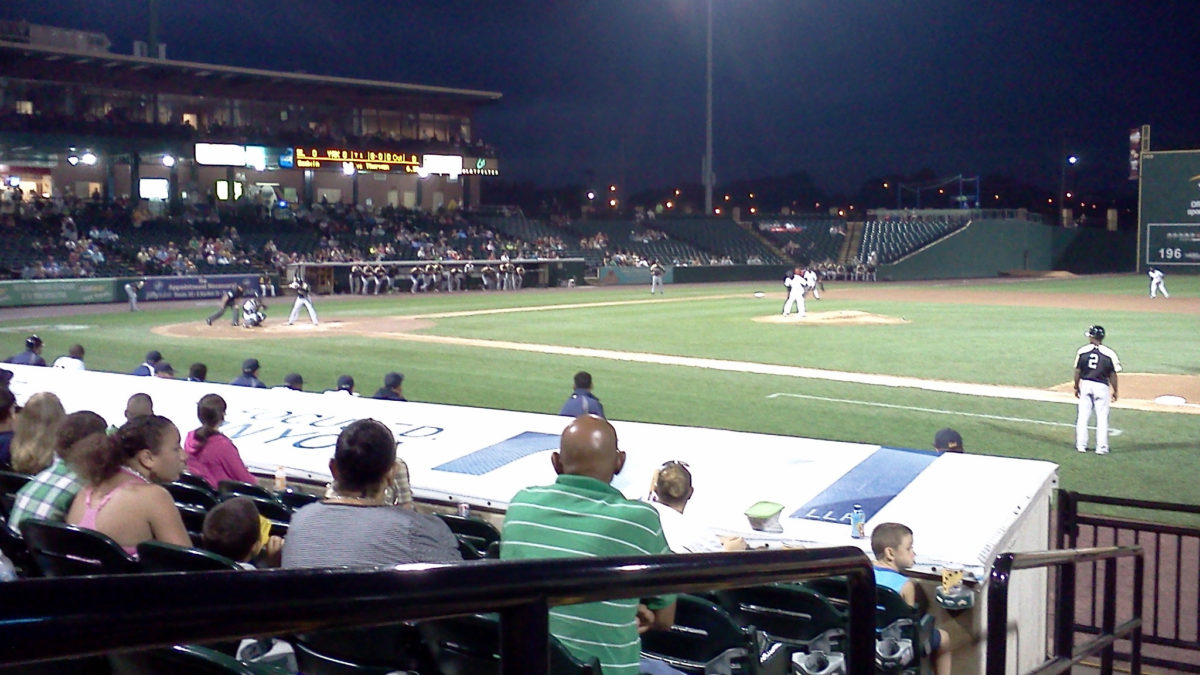
When I call Thurman “the face of the York franchise,” it’s became it’s true. Or at least, it feels true. He’s been with York since 2008 and is, I believe, the longest tenured Rev. He’s certainly made a career of the Atlantic League, at or near the league lead in all-time wins and strikeouts. He is something of a soft throwing pitcher, topping out with a fastball in the low 80s. Thurman gave up a run in the first, three more in the second (thus coughing up a 4-1 lead after the Revs put four on the board against Elarton in the bottom of the first), and none in the third. But it took Thurman 102 pitches to get through the three innings. He faced six batters in the first, including Koby Clemens (Roger Clemens‘ son) and Ryan Langerhans, nine batters in the second, and six more in the third. Of his 103 pitches, only 58 went for strikes.
Elarton was not much better, facing seven batters in the first and giving up four runs to Andy Marte, Chad Tracy (son of Colorado Rockies manager Jim Tracy, not the Nationals’ Chad Tracy), and Salvador Paniagua, until he finally got Mark Teahen to fly out for the third out. In the second and third he faced four each inning, but in the fourth he faced eight batters, driving up his pitch count to match Thurman’s at 103 exactly.
With the score knotted 4-4 and Zack Segovia on fresh to start the fourth inning, a York Revolution fan might have been forgiven for thinking that the game could go either way. It was late, 10:30, and the concession stands were closed and people were leaving, but the Revs had a chance. The Skeeters batted around on Segovia, scoring four runs, and when he left the game with two outs and the bases loaded, Stephen Penney came on and gave up two more runs, both unearned, when a routine grounder was misplayed by shortstop Ofilio Castro.
After the fourth, the game turned into something entirely different. Each manager, Mark Mason for the Revolution, Gary Gaetti for the Skeeters, brought in a succession of relief pitchers for an inning or two. The Skeeters didn’t score again until the eighth, when Anthony Slama issues a based loaded walk on four pitches to Langerhans. By this point, the time had reached midnight, and there was less than three hundred fans left in the stands.
There were two fans who stayed the course and kept the faith throughout this marathon. One sat at the front of section five (where I sat). As each Revolution batter came into the box, he would stand up, gesture at the section, and lead the fans in a chant, “Hit the wall!” The wall, in this case, being the Arch Nemesis, the outfield wall in left, 300 feet away and six inches taller than Boston’s Green Monster. (Why Arch Nemesis? The residential street immediately behind the wall is Arch Street.)
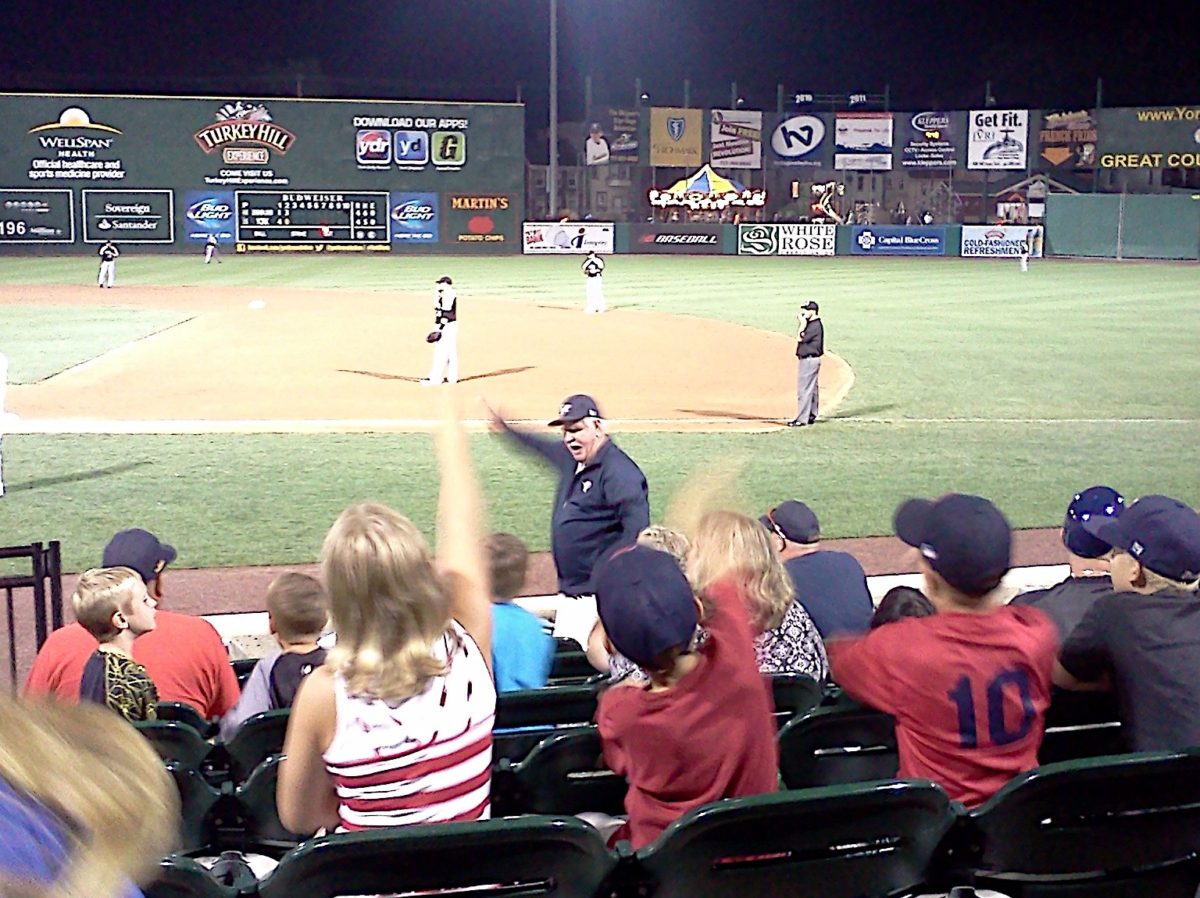
He had a rival, two sections over. Immediately after the chant of “Hit the wall!” went up, his rival would stand and rally hit section to shout “Over the wall!” It was a one-sided rivalry. The rival would then shout sarcastic things in the direction of the man at the front of section 5 and mock “Hit the wall!” I had to admit that there was some validity to the criticism of “Hit the wall!”; sending the ball over the wall would put runs on the board, while smacking the ball off the wall would keep it in play and not necessarily score any runs.
In the ninth inning it began to rain, a light drizzle at first that gradually strengthened so that by the middle of the inning the few who remained ran for cover under the overhang.
Yet, even down by five, the game wasn’t out of reach of the Revs. Driven from his seat the older man continued his chant of “Hit the wall!” and the first batter in the home half of the inning, Matt Spencer, hit a home run over the right field wall.
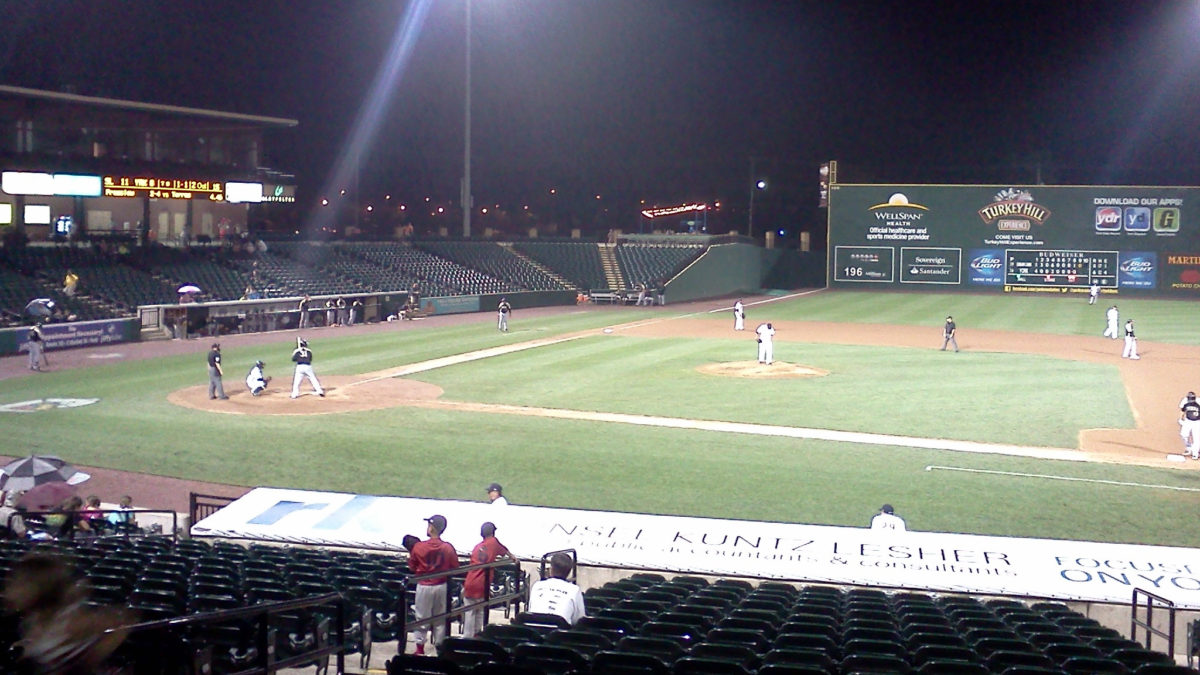
Typically at Sovereign Bank Stadium, Cannonball Charlie fires off a cannon after every Revs home run. With the rain, and perhaps because it was after 12:30 and he’d been sent home, there was no cannon blast. I will say that I usually jump six inches in my seat with every cannon blast at a Revs game, even though I know it’s coming. Kody Kirkland drove in Paniagua for another run, making it 11-8, but with two down Ruddy Yan grounded out to short to end the game.
The Skeeters had barely left the field before the ground team was out with the tarp. The few of us who were left filed out of the stadium and headed out into the rain.
It was 12:52 Sunday morning, four hours and five minutes after the first pitch. I’ve been to longer games, I’ve been to longer games in the rain (including a memorable 16-inning game in the Bronx between the Orioles and Yankees back in 2001), but this game was interminable.
I didn’t even get a voucher to come back to another Revolution game like they’d promised on the PA system six hours earlier. I think I’ll give the ticket office a call tomorrow and see if I can sort something out.
What’s play in the Atlantic League like? Is a four-hour 11-8 slugfest normal? Well…
I was talking about the Atlantic League at the recent Harrisburg Senators game I attended when someone standing in line asked if I’d been to a game when I said I lived near York. The thing is, I don’t have an easy answer to those questions.
In what I’ve seen, which I admit is an unrepresentative sample, there seems like there’s a mismatch between the hitting and pitching skill levels. I want to say that the Atlantic League has AA-quality arms and AAA-quality bats, but that’s not quite right; there’s MLB-calibre bats and arms on every team. Dontrelle Willis is putting together a solid season for the Long Island Ducks. The Phillies were looking hard at signing the Revolution’s Michael Weurtz. Revs pitching coach John Halama is a former Nationals pitcher who had several successful seasons in the Atlantic League. Jake Fox, who couldn’t quite put it together for the Cubs and Orioles, is a monster at the plate for Somerset. I mentioned Jimmy Van Ostrand up top; he’s tearing up Harrisburg, and he came to the Nationals organization from the Skeeters. But it still seems that for every close game where pitching, hitting, and defense all click for a tightly played, low scoring game, there’s another game where one of the wheels falls off and the balls fly and the hits fall in and the score reaches football-like numbers. That says talent disparity to me, and I think that’s to be expected given how players reach independent ball.
Some players reach the Atlantic League because they had obvious deficiencies in some aspect of their game that they could never master in organized ball. They’re still capable, they still have the desire to make improvements in their game, they still have the dream of making the show, but they fell through the cracks and they might have been among the last players cut from rosters in spring training one year. Other players couldn’t find even a minor league contract because of injury history and are looking for a shot to prove to an organization that they can play everyday and stay healthy. The goal for most of the Atlantic League players, then, is to play well enough to get noticed by a scout and get picked up by one of the major league organizations or one of the other professional leagues around the world. If Revs manager Mark Mason loses a player because his contract has been purchased by the New York Mets, that’s a happy problem to have.
Unfortunately, Mason has had many problems like that this year. Before the season began, York was touted by sportswriters who cover the league as the most talented and most dominant team in the league, not unlike the Washington Nationals this year. But thanks to signings and retirements the Revolution are at the bottom of the Freedom Division and Mason has had to rebuild the team on the fly as the season has worn on.
By and large, independent baseball isn’t very different from the affiliated minor leagues. If you attended a Frederick Keys or Hagerstown Suns game, the product you see on the field will be very similar. The players will be older than you’ll see in Hagerstown or Frederick (or Harrisburg or Bowie) because they’ve been through several levels of the minors and may even have played in the majors. You’re more likely to see players who don’t run out grounders in independent ball (that was the thing that surprised me the most) than you will in the minors, and you’ll see players who may be wizards with the bat and disasters with the glove. In short, it’s a lot like minor league baseball.
However, unlike in Hagerstown and Frederick, you’ll also see teams play to win. Independent ball pitchers aren’t on developmental pitch counts. The manager doesn’t have to put hitters into the line-up to make sure they have to get in a requisite number of at-bats for developmental and scouting purposes. In that sense, independent baseball is more like the major leagues than it is like the minors. Player development is important in the Atlantic League, but it’s not the only thing.
And, like the minor leagues, on field between innings entertainment is a big part of the experience. Last night’s game, because of the wet conditions, was toned down from the norm. There was a toy lawnmower race, there was a fruit race, there was an oversized pretzel toss, there was a strange game where two people had to knock over cans with baseballs affixed to their head with pantyhose.
In short, if you live in Loudoun County and you wonder what the Hounds will be like next summer, I’m here to tell you that what you’ll see will be familiar and won’t offend the Baseball Gods. Hopefully you’ll enjoy it. And hopefully you won’t have to witness many (or any) four hour long games.
My next York Revolution game? I’m not sure. It’s likely to be before I go to see the Senators again, probably the series against the Lancaster Barnstormers in two weekends.
For more pictures of Sovereign Bank Stadium and the York Revolution…
- Photos from last night’s game
- Photos from the York Revolution Fan Fest in April
- Photos from the first game I attended in York last summer
The box score and play-by-play for the game can be found here. I used it to supplement my notes from the game.
Note: Originally published at Federal Baseball.
